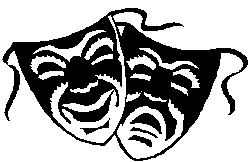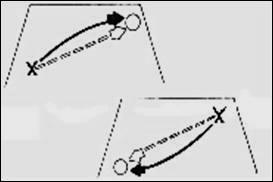
As the "Bloody Captain" from The Michigan Shakespeare Festival (2001)

As the "The Sheriff" from Calamity Jane - Lincoln High School (2008)


THEATRE DIRECTOR & TEACHER
Lincoln High School, Ypsilanti MI
This site is works best on a computer or tablet

UNIT ONE
INTRODUCTION TO THE THEATRE
ASSIGNMENTS
_________ Survey Due (20)
_________ Quiz on Theatre Terms (45)
Participation (20)
Bonus Points
Find a Monologue 3-6 minutes - Needs to be approved by ____________
Monologue needs to be memorized by ____________
Stage Terminology
Three Types of Staging


Stage Positions
Stage Right: The actor’s right as he stands onstage facing the audience.
Stage Left: The actor’s left as he stands onstage facing the audience.
Downstage: Toward the audience.
Upstage: Away from the audience. (Reason: Stages used to be “raked” or slanted, with the elevated part in back, so an actor moving away from the audience would literally be moving higher or up.)
Below: Toward the audience. Same as downstage of.
Above: Away from the audience. Same as “upstage of.” (An actor who walks below a piece of furniture walks between the furniture and the audience; an actor who walks above a piece of furniture walks between the furniture and the upstage wall of the setting.)
In: Toward the center of the stage.
Out: Away from the center of the stage
Onstage: The acting area within the set, visible to the audience.
Offstage: The parts of the stage not enclosed by the setting.
Backstage: The area behind the setting.
Wings: The offstage areas to the right and left of the acting area.
Greenroom: A backstage lounge used as a reception or waiting room for the actors.
Pit: The part of the auditorium where the orchestra may be located.
Planes: Imaginary lines on the stage floor, parallel to the edge of the stage. Downstage planes generally take focus.
Sightline: The line of sight from the audience’s point of view. If an actor is “within sightlines,” the audience can see him. If the actor is “outside of sightlines” the audience cannot see him.
Levels: Achieving various heights on stage through the use of platforms and scenery. Higher levels generally take the focus
The House: The auditorium where the audience sits. Sometimes referred to as the “Out-front,”
Curtains
Proscenium: The arch or frame enclosing the visible stage, the opening between the stage and the auditorium.
Main or Act Curtain: The curtain, hung just upstage of the proscenium, that opens or closes after each act or scene.
Asbestos or Fire Curtain: A fireproof curtain closing the stage from the audience.
Border (teaser): A short curtain hung across the stage above the acting area to mask the overhead lights from the audience; also, refers to overhead strip lights.
Legs: Pieces of cloth, usually hung in pairs, stage left and stage right, to mask the backstage area.
Traveler: A stage curtain upstage of the act curtain that opens to the right and left rather than moving up and down.
Backdrop (drop): A large piece of cloth upon which scenery is painted, fastened at the top and bottom to battens, and hung at the back of the stage setting. Sometimes it is just another curtain.
Batten: A large piece of wood or pipe from which scenery, lights, and curtains are suspended; also used at the top and bottom of a drop.
Stage Movement
Blocking: Pre-planned movement by the actors on the stage. Usually given by the Director.
Cross: Movement from one area to another. In writing it is abbreviated by “X.”
Curved cross: It is a cross that curves upstage so that the audience can see more of the actor as he moves across the stage.
Countercross: A movement in the opposite direction in adjustment to the cross of another actor. The instruction usually given is “Counter left” or “Counter right.” If only a small adjustment is necessary. The actor should make it without being told to do so. This should be done as naturally as possible.

Body Positions
Body positions apply to the actor as he faces the audience. There are five basic positions:
Cheating: (a.k.a. One Quarter) the body is a quarter turn away from the audience. This position is the most frequently used when two actors “share” a scene, for it places each of their bodies so that the audience can easily see them.
Full front: The actor faces directly front.
Profile: Two actors face each other directly
Full back: The actor stands with his back to the audience.
Open: An open position is one in which the actor is facing toward the audience, or nearly so. To open is to turn toward the audience. Since effective communication requires that the actor be seen and heard, he must—without sacrificing believability keep himself as open as possible.
Closed: A closed position is one in which the actor is turned away from the audience.
Upstaging: Pulling the audiences focus from another actor(s). There are three ways to upstage:
-
To stand directly in front of him.
-
To stand upstage of an actor while talking to him forcing him to turn away from the audience.
-
To make distracting movements or gestures while another actor is speaking.
Miscellaneous
Box set: A two-wall or a three-wall set composed of flats representing an interior of a room .
Counterweight system: A system of lines and weights that gives mechanical advantage to the raising and lowering of scenery. A common type of Fly System. (Fly: To raise or lower scenery.)
Flat: A wooden frame covered with cloth used as the basic unit of structure of a box set.
Places: The order for the actors and the crew to get to their positions.
The Fourth Wall: Imaginary wall in a box set - there isn’t four walls in a box set because the audience has to be able to see what is going on. “Breaking the Fourth Wall” is when the actor breaks the “reality” of the play by talking directly to the audience or acknowledging the in any way.